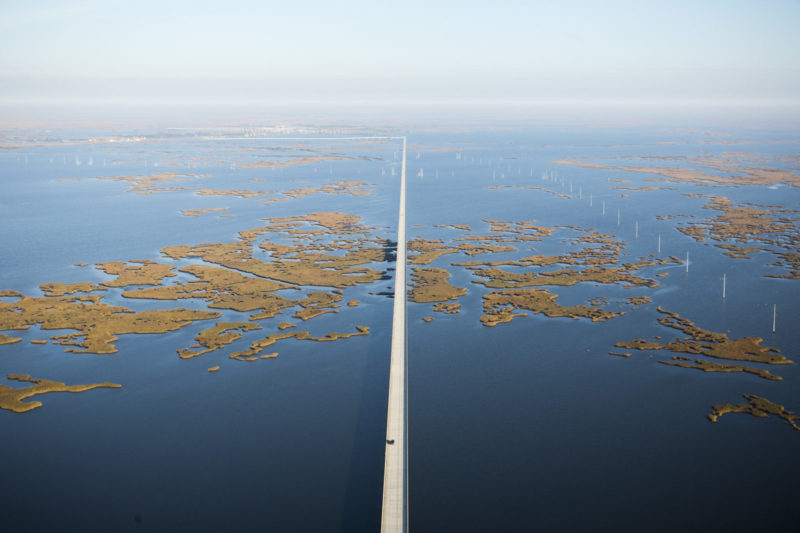
Henri Boulet, 54, grew up in a family of shrimpers in the southern part of Lafourche Parish, a long, skinny county that starts on Louisiana’s Gulf Coast and stretches north about 75 miles. His family lived in a little town called Larose, which was located slightly inland, so the family kept their shrimp boat on a barrier island called Grand Isle.
Climate Change is Already HereThis story was produced in collaboration with weather.com, which examined the effects of climate change in all 50 states.See how climate change is affecting the rest of the country.
As a child, Boulet would often ride with his father down to their boat, an hour’s drive on two-lane Louisiana Highway 1. Over the past half-century, he has seen the landscape change dramatically.
Recently, Boulet recalled how he’d driven onto a local bridge and looked down to see nothing but blue. “It’s scary. From the bridge I could see some marsh,” he said. “But I don’t see the miles of solid marsh that I saw growing up, driving to Grand Isle in the 1970s.”
In recent decades, the highway has flooded much more frequently.
In 2012, when Hurricane Isaac hit, storm surge covered the low-lying road and tore out chunks of asphalt. “It really pounded us,” Boulet said. “And it was only a Category One storm.”
After Isaac, like other storms over the past decade, a stretch of Highway 1 between Leeville and Golden Meadow was closed for several days. But it doesn’t take a storm to flood. Carol Terrebonne, who runs the Seafood Shed along that stretch of road, said even a high tide sends water into her market.
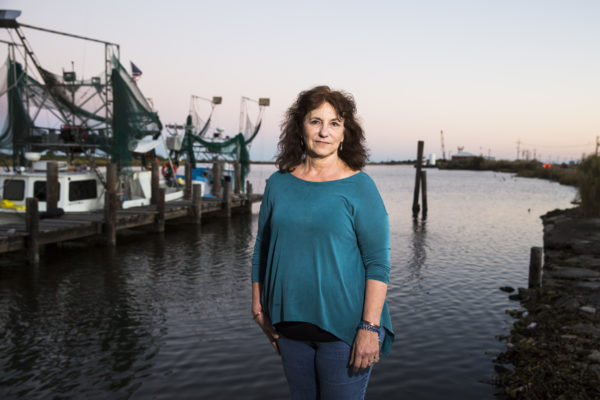
While any closure of this sliver of a road is a hardship for people who live in the area, it’s also a blow to the nation. That’s because Highway 1 is the only land route to Port Fourchon, a sprawling, deepwater harbor on the Gulf of Mexico that supplies nearly 20 percent of the nation’s oil and gas at any time. It’s connected to nearly 50 percent of the nation’s refining capacity and is a supply point for about 90 percent of offshore drilling vessels in the Gulf.
“I find it ironic that what threatens the future existence of Port Fourchon is the very thing that Port Fourchon was built to promote,” said David Muth, director of the Gulf Restoration Program for the National Wildlife Federation Federation.
Fourchon is linked to the Louisiana Offshore Oil Platform, or LOOP, the only port in the nation that can accommodate supertankers from the Persian Gulf. They dock at LOOP and pump oil through hoses connected to a moored base. The oil is sent 18 miles underwater to Fourchon, which sends it on via massive pipelines to be stored in a salt dome or a tank farm of metal cylinders that stands at the edge of Golden Meadow, 20 miles up Highway 1.
Because of its importance to the energy sector, Boulet said, anything that shuts down Highway 1 is basically a blow to the nation’s coffers. Oil and gas royalties are the second-largest deposit to the U.S. Treasury after income taxes. A 2012 analysis by the U.S. Department of Homeland Security found that a 90-day closure of Port Fourchon would result in a $7.8 billion loss of gross domestic product.
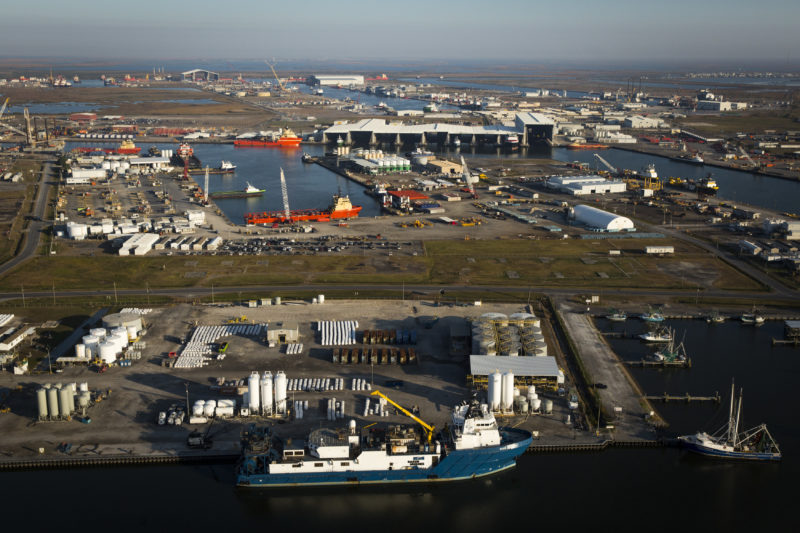
Boulet is the longtime executive director of the Highway 1 Coalition, which was formed 20 years ago to put the most vulnerable part of this highway into the air, far above the water. In 2011, half of that dream came true when the southernmost nine miles of the highway was replaced by an elevated toll road that towers on massive, concrete pillars 22 feet above sea level. The raised portion of the road connects Fourchon with Leeville, a sleepy town now tucked into the elbow of the massive structure.
At the entrance to town is an early-20th century cemetery where tipped gravestones are sinking sideways, sometimes leaving only a few letters above ground. The road’s asphalt seems particularly weathered here. It’s dotted on either side with shuttered buildings.
“I find it ironic that what threatens the future existence of Port Fourchon is the very thing that Port Fourchon was built to promote.”—David Muth, National Wildlife Federation
Tolls were levied for the first phase of the road to repay the bonds that funded it, along with a mix of local, state and federal funds. But Boulet and his coalition haven’t yet found a way to finance construction of the next $320 million segment north, a seven-mile stretch between Leeville and Golden Meadow.
The relative rate of sea-level rise here is among the highest in the world: four feet in the past 100 years. Part of this is a global phenomenon, due to expanding water caused by higher temperatures. Over the past 100 years, that has caused the water along this coast to rise a foot.
The other part is local. The mud under this part of the former Mississippi River delta has subsided —sank — three feet over the past 100 years.
Research has shown that subsidence can be tied to the extraction of hydrocarbons far underground, said Harris Cheramie, 73, as he sat on his front porch outside the Leeville Seafood Restaurant, which he runs with his wife. “It’s just common sense,” he said. “We pumped all this oil out of the ground, leaving it empty like a balloon.”
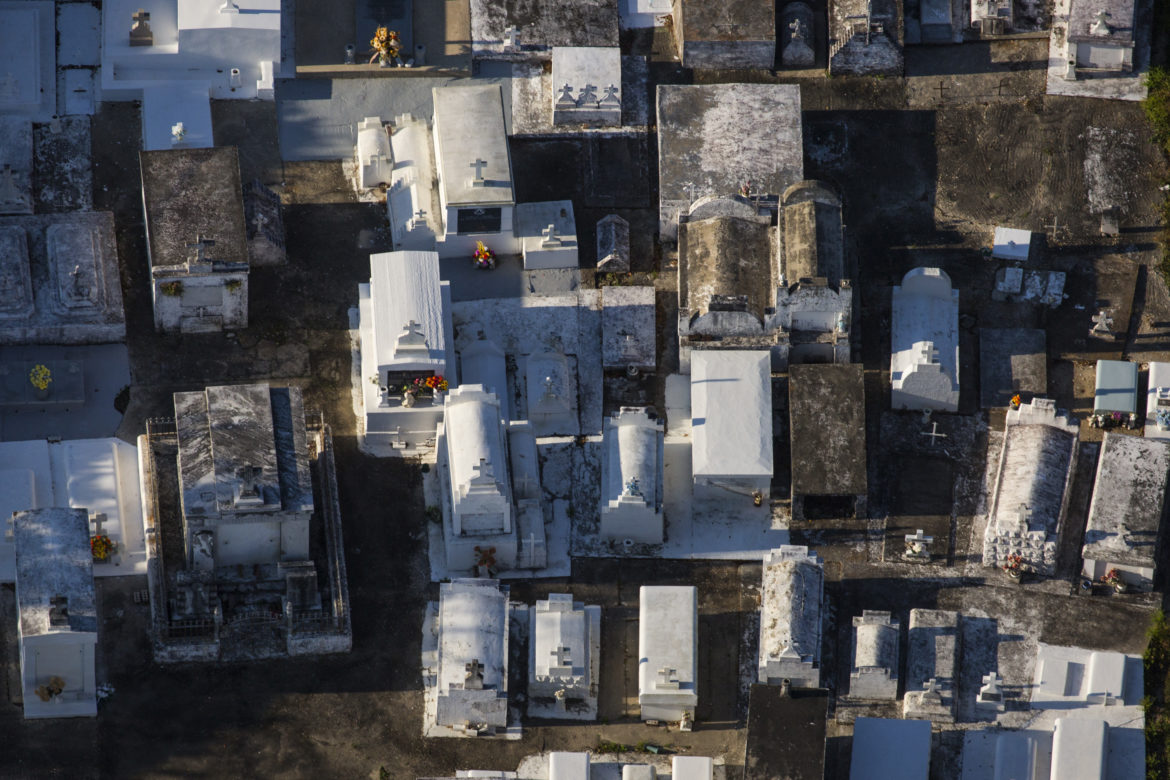
Once the road reaches Golden Meadow, it’s protected by a levee run by Lafourche Parish. It’s a source of pride that parish leaders began to build a levee system and taxed themselves for it a generation ago. “Because of what my father and others did, I have to carry on what the generation before me started,” said Hank Danos, 68, who has been active in the Highway 1 Coalition and owns Danos, a company that works with oil and gas companies. “People here taxed themselves for the levee, the port, and the highway.” Local companies will contribute, he said, but they can’t shoulder the entire price tag for Highway 1’s second phase.
“One would think if you had a business that was generating you $13 billion a year, you would put in a damn good road, to make sure you can keep operating.”—Ted Falgout, who ran Port Fourchon for 30 years
Danos is particularly concerned about the seven miles of this crucial throughway that remain exposed, flooding so easily that residents say that the next hurricane could wash parts of it into the sea. Scientists at the National Oceanic and Atmospheric Administration, which has measured Louisiana tides since the 1800s, predict that by 2027, the road will be underwater for more than 30 days of the year.
It’s hard for locals to understand why the feds haven’t come up with more highway construction money for Louisiana, given how heavily the country relies on Port Fourchon.
“The federal government has income coming from the Gulf of Mexico’s oil and gas wells to the tune of $8 billion a year, sometimes as high as $13 billion a year,” said Ted Falgout, 66, a south Lafourche native who ran the port for 30 years. “One would think if you had a business that was generating you $13 billion a year, you would put in a damn good road, to make sure you can keep operating.”
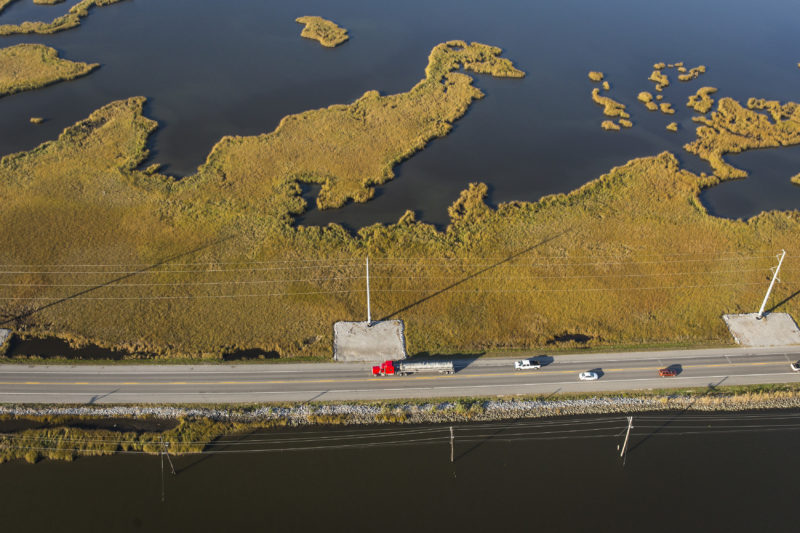
AT A FORK
Lafourche Parish curves along its long eastern border, ending in a clump at each end that gives it the shape of an old-school telephone receiver. A ribbon of blue, Bayou Lafourche, runs through the middle of the parish, connecting the Mississippi River to the Gulf.
Today, Highway 1 follows the bayou as it winds through the parish and the most rapidly eroding wetlands in the world. “Highway 1 was probably built to get some politician to his camp on Grand Isle,” said Windell Curole, 65, who has run the South Lafourche Levee District for 33 years. “Then as oil came in the 1930s, the road became that much more important.” A few decades later, oil pipelines were dug alongside the highway.
In recounting the history of places like Lafourche Parish, it’s not difficult to see how climate change was hastened by human activity, including levees and dams built to protect communities from flooding and canals dug for oil and gas exploration.
“What used to be a road running through a very healthy marsh is now a very narrow road with a lot of water around it. It’s obvious that something substantial has changed in the system.”—Louisiana state climatologist Barry Keim
“There’s now a basic consensus that humans are playing some role in changing the climate,” said Louisiana state climatologist Barry Keim. “Look at Highway 1: What used to be a road running through a very healthy marsh is now a very narrow road with a lot of water around it. It’s obvious that something substantial has changed in the system. It’s frightening, to be perfectly blunt.”
Falgout grew up South Lafourche, below the Gulf Intracoastal Waterway. The area was known for “an abundance of wildlife and seafood and, later, ways to make a living with oil and gas.”
Today, South Lafourche families largely work in the oil industry, though some still shrimp, fish or hunt on the side. His family, for instance, had “just barely made a living” until his father got a job with an oil company working as a gauger, checking oil levels in storage tanks.
Early French explorers had called the bayou Lafourche, French for “fork,” because the waterway split from the Mississippi River. That ended in the early 1900s, when the bayou was dammed at Donaldsonville to prevent flooding, Muth said.
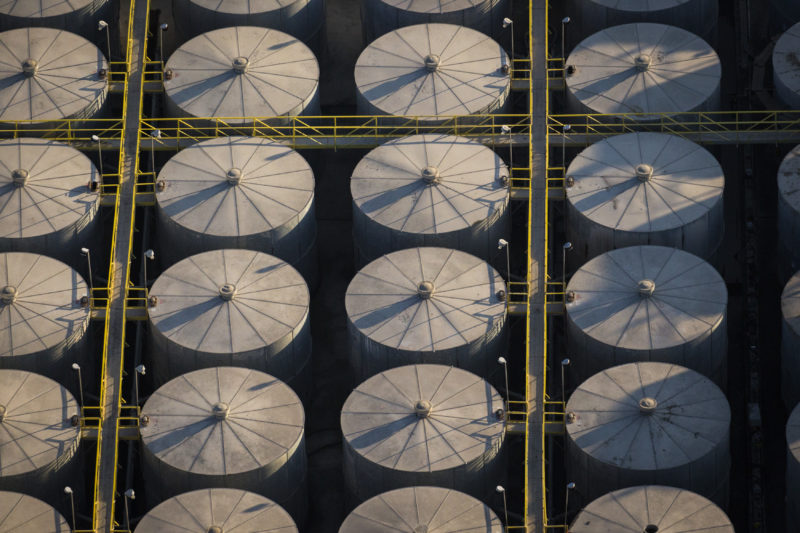
With the bayou blocked, there was no longer a flow of freshwater to keep saltwater from penetrating into the marsh. Salt crept into local drinking water. “So they installed a pumping station” to pull water over the river levee into the bayou, said Muth — a “ridiculous” bit of engineering to solve a problem caused by another bit of engineering.
Scientists now see how the salt flowed in, causing vegetation and trees to die. Without live roots to hold the delta mud together, the marshland became much more vulnerable to erosion.
As it turns out, water was just one part of the nourishment provided by the river. Sediment no longer flowed down the bayou to rebuild marshland. The resulting land loss made south Louisiana more vulnerable to hurricanes, said Keim, noting that 30 miles of wetlands can knock down a storm surge by 10 feet.
This happened to wetlands all along the Mississippi River, not just Bayou Lafourche. Levees built to rein in the river after the devastating flood of 1927 broke the cycle of floodwaters and the sediments they carried, which had helped maintain and build land.
“I don’t think that our restoration efforts will be successful enough to prevent Port Fourchon from becoming virtually an island one day.”—Ted Falgout
After the oil bonanza began in the 1930s, derricks and pumping platforms inundated the area south of the Gulf Intracoastal Waterway. Oil companies cut canals into the marsh, further tearing them up. “Back then, it just seemed like the earth had the ability to absorb whatever blow we gave to it,” Keim said. “But we did significant damage.”
In the 1960s, a state senator, A.O. Rappelet, envisioned an elaborate dock that would become Port Fourchon. Rappelet passed the legislation to create it, hoping to lure the banana trade from Central America.
The banana boats never came. After it was discovered that Rappelet had hired his own company to work at the port, he pleaded guilty to malfeasance in office.
For the next decade, Fourchon was mostly used as a dock for shrimp boats, Falgout said. But during the 1980s oil bust, companies consolidated their operations there and closed their small docks scattered along the coast. In the mid-1990s, when deepwater drilling was a small portion of oil production in the Gulf, Fourchon began to attract that business because of its easy access to deeper water. It now services 90 percent of deepwater structures.
On a recent day, boats backed in and out of an E-shaped slip in the port in a flurry of activity that workers there call the “Fourchon shuffle.” In other sections of the port, fenced-in yards contain large reels of pipeline, oil tanks and other industry supplies. Rows of trailers on stilts provide offices and housing for contractors. Shrimp boats are docked in another area, waiting for a cold front to push the shrimp to sea and into nets.
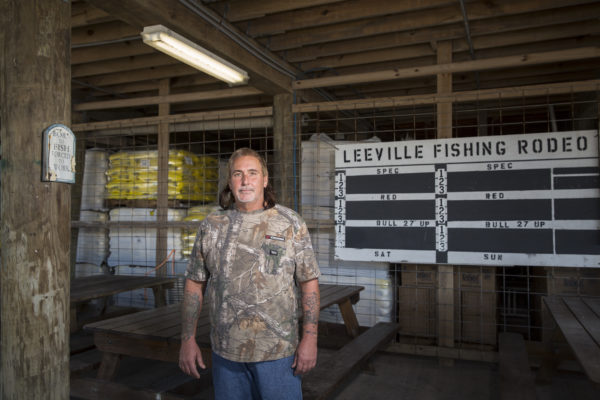
During his time at the port, Falgout worked to expand it into open water, using dredged material to build the land six feet above sea level. And in a way, the state is now at another fourche, a different sort of fork in the water, as it scurries to use dredged material and diversions from the river to build new marshland along the shrinking coast near Fourchon. Falgout believes in those projects. “But I don’t think that our restoration efforts will be successful enough to prevent Port Fourchon from becoming virtually an island one day,” he said. “I think that’s inevitable.”
Ultimately, to produce so much of the nation’s oil and gas into the future, the fate of Port Fourchon relies upon Highway 1, Falgout said. “It’s the goose that laid the golden egg, but the support of it is being neglected. One good hurricane and its nest will blow away.”
‘No marsh. Just gulf.’
Twenty years ago, Carol Terrebonne tired of flooding in her second shop, located in the small fishing town of Leeville. So she raised it 2.5 feet off the ground. Now at high tides, the water floods the shop again.
“The tide moves in so quickly now,” said Lafourche Parish Councilman Daniel Lorraine, shaking his head as he talked with constituents in Leeville along what’s known as Old Highway 1 — the sea-level road that has been bypassed by the elevated highway. Cars coming off the new road can exit here at Leeville.
“The tide moves in so quickly now.”—Lafourche Parish Councilman Daniel Lorraine
Old Highway 1 is now free of eighteen-wheelers rattling past. Store owners and bait shops on the road say few people stop to get potato chips or cans of soda. It’s a tough time in the area, with the oil and seafood industries struggling with low prices.
Gail Serigny Hayes doesn’t mind that 1,200 semi trucks a day now rumble on the road above, headed to the port. “We’ll still be that little fishing community,” said Hayes, 56, who has worked the counter at her family’s shop, Gail’s Bait Shop, since she was a teenager. She’s noticed an uptick in business associated with a new fishing pier spearheaded by Lorraine, who comes from a local fishing family. “But when we were growing up, there were commercial fishermen who did nothing else. Now, you just can’t do that.”
Shrimp and crabs have been scarce, said William “Red” Simons, 52, as he walked into a grocery store in Leeville. “No seafood this year. No marsh. Just gulf,” said Simons, who suspects that the crustaceans are getting eaten by saltwater fish moving into what’s left of the marsh.
T-Roy Borne, 48, another crabber and shrimper, nods. “All the land has become open water,” Borne said. “They should have never plugged up Bayou Lafourche by the river.”
Borne is beginning to suspect that something else might be at work. “You know, people are talking about climate change,” he said to Simons. “Do you think there’s anything to that?”

Credits
Written by Katy Reckdahl
Katy Reckdahl (@katyreckdahl) is a New Orleans-based reporter who is a frequent contributor to the New Orleans Advocate and has written for The Times-Picayune, the New York Times, the Daily Beast and the Christian Science Monitor. She has won several first-place awards from the New Orleans Press Club, including three for her work for weather.com, and several national awards, including a James Aronson Award and a Casey Medal for Meritorious Journalism.
Photography by Edmund D. Fountain
Edmund D. Fountain (@edmundfountain) is a photographer based in New Orleans. He is a recipient of the Dart Award for Excellence in Coverage of Trauma, the Casey Medal for Meritorious Journalism, and was a finalist for the Pulitzer Prize in 2010 for his work with the Tampa Bay Times. He is a frequent contributor to the New York Times, the Washington Post and NPR.
Edited by Steve Myers, The Lens
Project edited by Patty Cox and Kevin Hayes, weather.com

